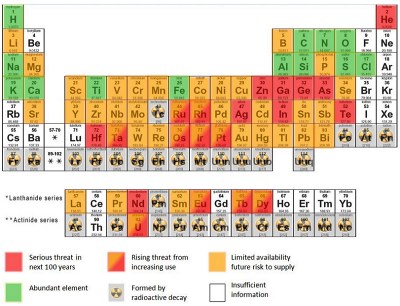 Did you know there will soon be gaps in the Periodic Table? I say gaps, it’s not so much gaps as greyed out boxes where an element has become so scarce that our using it will no longer be a technological option. I’ve written about materials security before but the issue was raised by The UK House of Commons Science and Technology Committee, which is currently in the middle of an inquiry into strategically important metals.
Did you know there will soon be gaps in the Periodic Table? I say gaps, it’s not so much gaps as greyed out boxes where an element has become so scarce that our using it will no longer be a technological option. I’ve written about materials security before but the issue was raised by The UK House of Commons Science and Technology Committee, which is currently in the middle of an inquiry into strategically important metals.
According to the Chemistry World blog as part of that inquiry, David Willetts MP was summoned to give evidence. When asked to clarify what he was referring to when he talked about ‘rare earths’, the minister brandished a copy of this article from Chemistry World. Of course, he didn’t mean only rare earths as chemists know them, but rare elements.
The article to which he referred is by Emma Davies and highlighted a periodic table showing which metals and non-metals are endangered elemental species. The original version of that PT can be seen here. Many of the elements will remain relatively abundant, among them silicon, carbon, nitrogen, oxygen and iron. But, some are on the seriously endangered list including helium, germanium, hafnium, neodymium.
The Chemistry Innovation page gives some examples of elements that may become increasingly scarce over the next few decades:
Platinum is largely obtained from two mines in South Africa at a rate of 200 tonnes per annum with a yield of about 3 grams per tonne from its ore.
Copper, zinc, tin and nickel have seen a near exponential rise in production. A future world population of 9 billion people cannot continue to use copper at the levels tied up in western lifestyles — there isn’t enough of this metal on the planet.
The ruthenium price quadrupled in 2006 as new uses in hard drives allowing a tenfold increase in data storage caused a 45% surge in demand. Tellurium prices multiplied 25 times in 2006 following an increase in applications for the metal. Gallium, tellurium and selenium are past their production peaks. Gallium use in the electronics industry is projected to outstrip known reserves in 5 years. Rhodium produces more than 30,000 kg of carbon dioxide per kg of the element mined (before refining). Neodymium supply is mostly controlled by China. Tantalum is chiefly obtained from mines in Congo and conflict has occurred in the region over control of the mine areas.
If you thought food, water and oil security were going to be significant issues during the 21st century just wait until the major mineral wars start. Of course, there is always landfill mining to fall back on, but even that won’t solve the coming copper or phosphorus shortages…
To lighten the mood or perhaps to emphasise the problem someone ought to do a cover version of Tom Lehrer’s The Elements with appropriate gaps (for endangered elements) and quiet spots for those that are in trouble.